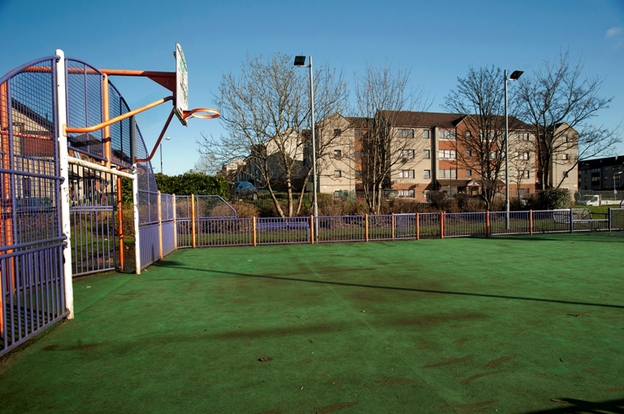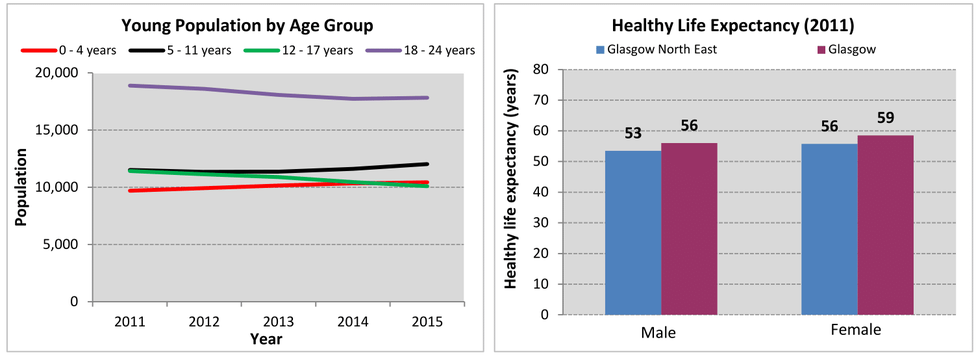NE Sector
NE Sector
Sighthill, Roystonhill and Germiston
Springburn
Balornock and Barmulloch
Robroyston and Millerston
Blackhill and Hogganfield
Ruchazie and Garthamlock
Easterhouse
Baillieston and Garrowhill
Mount Vernon and East Shettleston
Tollcross and West Shettleston
Springboig and Barlanark
Riddrie and Cranhill
Haghill and Carntyne
Dennistoun
Calton and Bridgeton
Parkhead and Dalmarnock
Children and Young People’s Profiles
*Please note that this profile is based on data from the 2011 Census.*
Download a printer friendly version of this profile.
Glasgow North East has a population of 50,405 children and young people (aged 0-24 years).
 Locality Comparison with Glasgow
Locality Comparison with Glasgow
The proportion of school age children in Glasgow North East is higher than Glasgow as a whole. 11% of under 25s are from a minority ethnic group. 79% of children live within 400m of green space. The locality has more babies exposed to passive smoking (+31%) and more referrals to the Scottish Children’s Reporter Administration (+24%) when compared to Glasgow overall, as well as higher levels of obesity in P1 children (+17%). S4 pupil attainment is lower (-12%) than the Glasgow average and more 16-19 year olds are not in employment, education or training (+23%). Likely development difficulties in pre-school children are higher than the Glasgow average (+17%) but communication delay in young children is lower than average (-2%).
 The number of 12-17 year olds in Glasgow North East has decreased by 12% since 2011, while the number of 0-4 year olds has increased by 8%. Healthy life expectancy for males and females is approximately 3 years lower than Glasgow as a whole.
The number of 12-17 year olds in Glasgow North East has decreased by 12% since 2011, while the number of 0-4 year olds has increased by 8%. Healthy life expectancy for males and females is approximately 3 years lower than Glasgow as a whole.
 Pupil attainment in Glasgow North East is lower than in Glasgow overall, while child poverty and P1 obesity levels are slightly higher than the Glasgow average. The numbers of children living in proximity to green space and primary school children who walk to school are similar to Glasgow overall. Secondary school attendance and referrals to children and adolescent mental health services are similar to the Glasgow average, while the proportion of children and young people from minority ethnic groups is lower.
Pupil attainment in Glasgow North East is lower than in Glasgow overall, while child poverty and P1 obesity levels are slightly higher than the Glasgow average. The numbers of children living in proximity to green space and primary school children who walk to school are similar to Glasgow overall. Secondary school attendance and referrals to children and adolescent mental health services are similar to the Glasgow average, while the proportion of children and young people from minority ethnic groups is lower.
Notes
1. Data sources: Census 2011, GCPH, Glasgow City Council, HMRC - Child Poverty Unit, ISD Scotland, National Records of Scotland (NRS), Transport Scotland, Sustrans, Police Scotland, the Scottish Government and the Urban Big Data Centre, Glasgow University.
2. Indicators are aggregated using latest available datazone (2001 or 2011); neighbourhood boundaries based on 2001 datazones.
3. All count figures of less than 5 (denoted as ‘< 5’) have been suppressed to avoid any potential identification.
4. Populations presented in the population trend chart, also used to calculate healthy life expectancy estimates, use NRS small area population estimates for the years 2011 - 2015.
5. ‘Healthy life expectancy’ is an estimate of the average number of years people are likely to spend in good health. It is calculated using population estimates, death registrations and self-assessed health from the 2011 Census.
6. Denotes children referred to the Scottish Children’s Reporter Administration for an offence or non-offence related reason.
There is a downloadable document providing detailed notes and definitions on the information presented in this profile.
There is a downloadable Excel workbook containing the data used in all of the profiles. This workbook also includes alternative output formats and further breakdowns of some of the variables.
